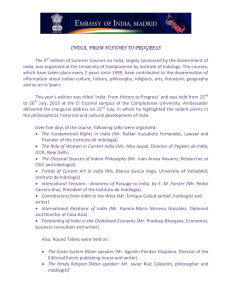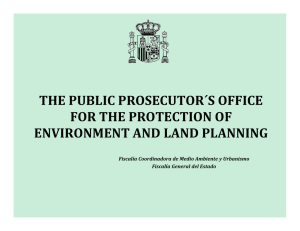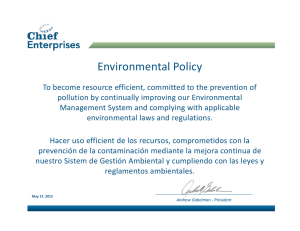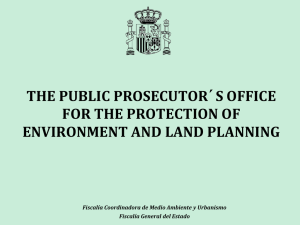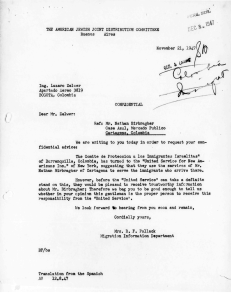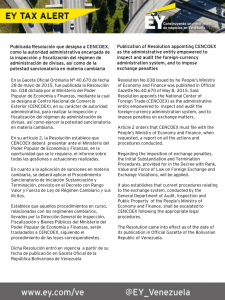Presentation of Colombia`s First National Communication to the
Anuncio
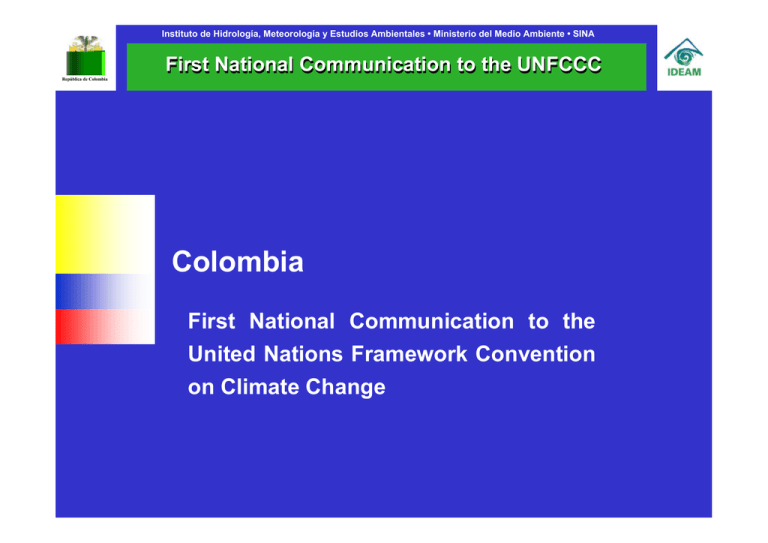
Instituto de Hidrología, Meteorología y Estudios Ambientales • Ministerio del Medio Ambiente • SINA First National Communication to the UNFCCC República de Colombia Colombia First National Communication to the United Nations Framework Convention on Climate Change Instituto de Hidrología, Meteorología y Estudios Ambientales • Ministerio del Medio Ambiente • SINA República de Colombia The UN Framework Convention on Climate Change Adoption: UNFCCC adopted in 1992 during the Earth Summit at Rio. Became effective in 1994 States-Parties: 186 states have ratified the UNFCCC so far. Colombia did so in 1994 Objective: To stabilize greenhouse gas concentrations in the atmosphere at a level that would prevent dangerous anthropogenic interference with the climate system. Such a level should be achieved within a time-frame sufficient to: • Allow for ecosystems to adapt naturally to climate change • Ensure that food production will not be threatened • Allow economic development to proceed in a sustainable manner Commitments: Among the commitments made is the preparation of National Communications. Instituto de Hidrología, Meteorología y Estudios Ambientales • Ministerio del Medio Ambiente • SINA First National Communication of Colombia República de Colombia è è è è è è è Introduction Executive summary National Circumstances National Inventory of Greenhouse Gases (GHG) sources and sinks-1990 and 1994 ü Five sectors: Energy, Industrial Processes, Agriculture, Land Use Change and Forestry (LUCF) and Waste. ü Reports the national emissions of direct GHG (CO2, CH4, N2O), indirect GHG (CO, NOx, NMVOC); SO2 (aerosol precursor) and the capture of CO2 by the LUCF sector. ü In order to determine the direct aggregate effect of the various GHG on climate change (Global Warming Potential), emissions were also expressed in terms of CO2 equivalent. Actions to mitigate GHG emissions (1994-2000). Vulnerability and means of adaptation to the effects of global climate change in: coastal zones, water resources, high plateau zones, glaciers and other ecosystems, soils and land affected by desertification, vegetation covers, agricultural sector and communities affected by dengue and malaria. Technical, financial constraints and recommendations ü Methodological problems due to the use of the IPCC directives ü Problems in obtaining information. ü Recommendations for technical and financial support in the framework of future National Communications. Instituto de Hidrología, Meteorología y Estudios Ambientales • Ministerio del Medio Ambiente • SINA Colombia: National Circumstances República de Colombia AREA AND REGIONS: 2’070.408 Km2 (1’141.748 Km2 continental land mass and 958.660 Km2 territorial waters). Fourth largest country in South America and the only one with Caribbean and Pacific Coasts. Five main natural regions on the mainland: Caribbean, Andean, Pacific, Orinoquia and Amazonia CLIMATE: The greater part of the country enjoys an annual average of 24-28oC • • • PRODUCTION OF WATER Magdalena-Cauca basins and basins draining into the Caribbean: 25% of annual water production in the country (95% of water used in production and domestic activities). Pacific Region: Runoff of 4000-12000 mm/year and > 14000mm/year in some areas. Areas suffering from excessive deficits (200500mm/year): Guajira, San Andres and Providencia Islands, Cesar. The Sabana de Bogota is the most critical (low natural offer of 500 mm/year and the greatest population pressure in the country) Instituto de Hidrología, Meteorología y Estudios Ambientales • Ministerio del Medio Ambiente • SINA Colombia- National Circumstances República de Colombia Population Ø Ø Ø Ø Ø 42 million: third largest in America Andean Region (65% ); Caribbean Region (20%); Pacific Region (11%); Amazonia and Orinoquia (4%) 71% in urban areas. Urban population is not only concentrated in the country’s capital Bogota (15%) but is widely distributed among various cities: Cali and Medellín, with nearly 2 million each, and Barranquilla with over a million people. These four cities combined account for about 30% of the total. Colombian cities’ inhabitants experienced a large increase from 57% of the total population in 1970 to 71% in 2000. 90% of the population is under age 50 Colombia´s average GDP growth 1991-2000: 2.6% Ø Regional GDP Structure (year 2000): Andean (74%), Caribbean (15,61%), Pacific (3.5%) Structure of the real GDP (1999) Ø Trade and services sectors (50%), agriculture, livestock and mining activities (22%), manufacturing (13%), construction (4.21%) Instituto de Hidrología, Meteorología y Estudios Ambientales • Ministerio del Medio Ambiente • SINA República de Colombia National Inventory of GHG -1990 and 1994 (Gg) TOTAL EMISSIONS OF GHG AND OTHER GASES -1990 (Gg) Direct Greenhouse Gases Other Gases Sectors CO2 Energy Industrial Processes Agriculture Land Use Change and Forestry Waste Total Country (Gg) 46.886,1 4.744,5 11.879,8 63.510,4 CH4 N2O CO NOx NMVOC SO2 268,3 0,2 1.517,2 4,2 173,9 1,3 0,2 76,0 0,03 1,9 2.602,5 2,4 2.184,9 37,0 249,9 0,9 44,0 1,05 394,4 25,3 135,5 6,3 1.963,9 79,4 4.826,7 295,9 419,7 141,8 TOTAL EMISSIONS OF GHG AND OTHER GASES -1994 (Gg) Direct Greenhouse Gases Other Gases Sectors CO2 Energy Industrial Processes Agriculture Land Use Change and Forestry Waste Total Country (Gg) 55.351,7 5.212,3 16.540,0 77.103,9 CH4 N2O CO NOx NMVOC SO2 284,4 0,4 1.634,3 4,2 193,4 1,5 0,3 87,5 0,03 2,0 2.874,5 289,48 2,9 1,1 2.178,0 43,8 37,0 1,05 423,57 29,8 162,45 7,8 2.116,7 91,3 5.092,3 335,4 453,3 170,2 Instituto de Hidrología, Meteorología y Estudios Ambientales • Ministerio del Medio Ambiente • SINA República de Colombia National inventory: Balance in Gigagrams Aggregate Balance of CO2 Emissions and Capture -2.034,7 1994 77.103,9 -1.010,8 1990 -10.000,0 63.510,4 0,0 10.000,0 20.000,0 30.000,0 40.000,0 50.000,0 60.000,0 70.000,0 80.000,0 90.000,0 Gigagrams Capture Emission Instituto de Hidrología, Meteorología y Estudios Ambientales • Ministerio del Medio Ambiente • SINA República de Colombia National Inventory: CO2 Emissions of the Energy Sector (Tons) SECTOR EMISSIONS OF CO2 (1990) 18.000.000 16.352.600 16.000.000 11.977.900 14.000.000 11.646.900 12.000.000 Tons 10.000.000 8.000.000 6.000.000 3.019.400 4.000.000 1.203.300 2.000.000 869.100 788.000 284.200 0 National Transport Generation & Transformation Manufacturing Industry Residential Other unidentified sectors Farming and mining Commercie & Institutions Construction Instituto de Hidrología, Meteorología y Estudios Ambientales • Ministerio del Medio Ambiente • SINA National Inventory: Transport Sector Emissions. República de Colombia CO2 emisisons by transport (000 tons) 1990 90.000 80.000 94.706 100.000 70.000 60.000 27.381 30.000 20.000 10.000 1.843 40.000 16.353 50.000 Mexico Argentina Colombia Uruguay Instituto de Hidrología, Meteorología y Estudios Ambientales • Ministerio del Medio Ambiente • SINA National inventory República de Colombia Colombia´s Share of World Emissions of CO2 0,3 0,29 0,28 0,30 0,27 0,26 0,25 0,24 0,25 0,23 0,22 1990 1994 Instituto de Hidrología, Meteorología y Estudios Ambientales • Ministerio del Medio Ambiente • SINA República de Colombia National inventory Comparison of Global CO2 Emissions Total National Emissions of CO2 -1990 (Gg) 6.000.000 4.914.351 Thousands of tons 5.000.000 4.000.000 3.000.000 2.372.300 2.000.000 1.124.532 1.000.000 465.755 308.632 226.057 101.585 63.510 33.223 Argentina Colombia Ecuador 0 USA Russia Japan Canada Mexico Spain Instituto de Hidrología, Meteorología y Estudios Ambientales • Ministerio del Medio Ambiente • SINA Colombia Vulnerability to Climate Change Vulnerability of Coastal and Island Zones 1600000 1800000 Vulnerability of Glacier zones 400000 600000 800000 1000000 1200000 1400000 ESCENARIO DE ESCORRENTIA [mms] CON AUMENTO DE PRECIPITACIONES EN UN 30% Vulnerability of Soils and Land in process of Desertification Vulnerability of Water Resources 200000 ZONA DE PRONOSTICO INESTABLE -77777 200 600000 600 1500 800000 4000 7000 10000 1000000 13000 1200000 1400000 1600000 1800000 Vulnerability of Ecosystems Vulnerability of Agriculture Vulnerabilidad of Human Health Instituto de Hidrología, Meteorología y Estudios Ambientales • Ministerio del Medio Ambiente • SINA República de Colombia Climate Change Scenarios for the Vulnerability Assessment Climate Chamge Scenaros used for the Vulnerability Assessment in the National Communication: •Sea Level Rise: A sea level rise of 0.8-1 meter by the year 2100 was projected for the Caribbean and Pacific Coast of Colombia •Air Temperature: Increase of the mean annual temperature of 12 oC over the period 2050-2060 •Precipitation: Changes of +15% in anual precipitation patterns oberved over the period 1061-1990 are likely to occur in the different regions of the country. Instituto de Hidrología, Meteorología y Estudios Ambientales • Ministerio del Medio Ambiente • SINA República de Colombia Vulnerability of the Colombian Coastal Zone to the Sea Level Rise Ø 4.900 km2 of lying coast would be affected by permanent flooding ØNatural systems (beaches, coast swamps by marshers and mangroves) would be the worst affected by erosion and coastal flooding Ø 1.4 million people (4% of the national total) live in the coastal area (Caribbean and Pacific) which would be affected by sea level rise, 85% of them live in urban areas Instituto de Hidrología, Meteorología y Estudios Ambientales • Ministerio del Medio Ambiente • SINA Vulnerability of the Caribbean Coastal Zone Santa Marta Barranquilla Cartagena COLOMBIA Vulnerability High: Permanent flooding Moderate: Formation of Pools to Total Flooding Low: Deepening of bodies of water to Formation of pools Ø56% of the population would be affected by flooding Ø9% of urban households and 28% of rural households would be highly vulnerable to flooding Ø4.9% of the agriculture area would be exposed to different degrees of flooding, 49.5% of which would be highly vulnerable (banana 39.2%; african palm 9.7%; transient tradable crops 6.8%) ØThe industrial area would be highly vulnerable to flooding: 75.3% in Barranquilla and 99.7% in Cartagena Ø44.8% of the road infraestruture would be highly vulnerable to flooding Instituto de Hidrología, Meteorología y Estudios Ambientales • Ministerio del Medio Ambiente • SINA Vulnerability of the Colombian Pacific Coast to the Sea Level Rise Ø13% of households are highly vulnerable and 62% are moderately vulnerable. Ø48% of households in urban areas and 87% of households in rural areas would be highly vulnerable ØBuenaventura (main commercial port in the Pacific coast), Tumaco y Satinga would be highly vulnerable Instituto de Hidrología, Meteorología y Estudios Ambientales • Ministerio del Medio Ambiente • SINA Vulnerability of San Andres Islands ØThe total area of the island of San Andres could be reduced by 17% ØMost affected zones by inundation: those containing the richest of the island´s natural resources and areas where the tourism industry and commerce are established. The high vulnerability of these zones is due to the presence of infills which were built over in the 1950s. THREAT HIGH MODERATE LOW Ø The public service infrastructure would be affected, particularly the sewerage system, water supplies and roads. ØCurrent processes of erosion would increase Instituto de Hidrología, Meteorología y Estudios Ambientales • Ministerio del Medio Ambiente • SINA Vulnerability of soils and land affected by desertification Ø Area currently affected by desertification : 4’828.875 Hectares (representing 4.1% of national territory) Ø Area potentially desertified by climate change: 3.6 million Hectares Ø With climate change desertified land and soils could cover 8% of the country (Caribbean plains, Andean valleys, Cundinamarca-Boyaca plateau, Nariño) including the main development poles (agriculture, livestock breeding, mining, urban and transport) Instituto de Hidrología, Meteorología y Estudios Ambientales • Ministerio del Medio Ambiente • SINA Vulnerability of the hydrological regime Effects of climate change on the hydrological regime: ØIn some areas, there would be an increase in levels of runoff norma, where distribution over time will be more uniform. ØIn other areas, there would be a decrease in levels of runoff norma, where distribution over time would be much more varied. Instituto de Hidrología, Meteorología y Estudios Ambientales • Ministerio del Medio Ambiente • SINA Vulnerability of the hydrological regime Ø 50 % of the country would be affected to a high/very high degree by the magnitude of the changes in runoff norma or by complete changes in the functioning of the entire hydrological regime ØThere would be drastic changes to the hydrological regime in the Amazon basin. VULNERABILITY TO CLIMATE CHANGE (REDUCTION OR INCREASE) IN WATER SUPPLY NONE LOW MEDIUM HIGH VERY HIGH DRASTIC CHANGES OF DYNAMICS Instituto de Hidrología, Meteorología y Estudios Ambientales • Ministerio del Medio Ambiente • SINA Vulnerability of high mountain ecosystems PRESENT CLIMATE (1 x CO2) FUTURE CLIMATE (2 x CO2) Hectare s Hectares Hectares Change (%) Páramo 323.000 84.830 -238.170 -75 Superpára mo 40.500 6.000 -34.500 -85 Glacier zones 45.500 1800 -43.700 -95 Vegetation DIFFERENCE BETWEEN FUTURE AND PRESENT CLIMATES ( 2 x CO2 - 1 x CO2) Instituto de Hidrología, Meteorología y Estudios Ambientales • Ministerio del Medio Ambiente • SINA Vulnerability of the Agricultural Sector PARAMETERS BIOCLIMATIC RANGES WITH HIGH SOIL OFFER COLD, VERY HUMID (Hectares) COLD, RAINY ( Hectares) PARAMO, VERY HUMID (Hectares) FUTURE SCENARIO* 2 x CO2 CURRENT SCENARIO 361021 92240 55366 191854 (-46.9%) 49767 (-46.0%) 27405 (-50.5%) INTENSIVE AGRICULTURE SOILS AFFECTED BY DESERTIFICATION IN DRY ZONES Increase of 1.4% BANANA, PALM OIL AND SUGAR CANE PLANTATION AREAS SUSCEPTIBLE TO DESERTIFICATION Increase of 3.0% IRRIGATION DISTRICTS NUMBER OF DISTRICTS IN DESERTIFICATION AREAS IRRIGATION DISTRICT AREAS WITH DESERTIFICATION 15 32.2% 23 91.3% Instituto de Hidrología, Meteorología y Estudios Ambientales • Ministerio del Medio Ambiente • SINA Vulnerability of human health to climate change ZONAS DE DESARROLLO DE LA MALARIA ZONAS DE DESARROLLO DEL DENGUE ØThe zones most vulnerable to malaria after climate change would cover all municipalities in Choco and Guaviare, some of Putumayo, Caquetá, Amazonas, Meta, Vichada, Vaupés, Guainia, Arauca, the Pacific watershed of the Departments of Nariño, Cauca and Valle, UrabáAntioquia, southern Guajira, Catatumbo the lower Magdalena, lower Cauca, Nechi, upper San Jorge and upper Sinú. ØExperts agree that the areas most vulnerable to dengue would be those where it is now most prevalent: Santander, Norte de Santander, Tolima, Huila, Atlántico and Valle del Cauca. Instituto de Hidrología, Meteorología y Estudios Ambientales • Ministerio del Medio Ambiente • SINA Measures for adaptation • Actions in the integrated management plan for coastal areas should be strengthened. • For páramo ecosystems, action should be designed to restrict the spread of agricultural activities in high mountain areas. • In the health sector, health services need to be strengthened in zones identified as vulnerable. • The sensitivity of producers to changes in the water offer should be reduced. Instituto de Hidrología, Meteorología y Estudios Ambientales • Ministerio del Medio Ambiente • SINA FIRST NATIONAL COMMUNICATION: COLOMBIA ACTION REQUIRED: TECHNICAL •Measures should be defined to adapt ecosystems and human health to the adverse effects of climate change. Measures should be defined to mitigate GEI gases through a national mitigation strategy. •This first National Communication will be the basis for presentation of two projects to GEF. The first refers to the vulnerability of the agricultural sector to the effects of climate change. The second refers to the vulnerability and measures be taken by the Colombian Caribbean islands to adapt to the effects of climate change. Instituto de Hidrología, Meteorología y Estudios Ambientales • Ministerio del Medio Ambiente • SINA PFIRST NATIONAL COMMUNICATION: COLOMBIA ACTION TO BE TAKEN: POLITICAL •This First National Communication will be the basis for the structuring of a national climate change policy •An inter-institutional working agenda for climate change should be drawn up in order to avoid duplication of effort and to present a single national and international position •Institutional capacity should be technically and financially strengthened in order to ensure that future National Communications are correctly prepared. Instituto de Hidrología, Meteorología y Estudios Ambientales • Ministerio del Medio Ambiente • SINA INSTITUTIONS CONSULTED Ministry of the Environment Ministry of Mines and Energy Ministry of Transport Ministry of Agriculture Ministry of Health Ministry of Development Ministry of Foreign Trade Superintendency of Public Services Regional Development Corporations CARs Asociación de Corporaciones Autónomas Regionales Asociación Nacional de Industriales -ANDI Asociación Colombiana de Reforestadores -ACOFORE Asociación de Cultivadores de Caña de Azúcar -ASOCAÑA Centro de Estudios Ganaderos -CEGA Centro de Estudios para la Investigación de la Caña de Azúcar Centro de Investigaciones del Café - CENICAFE Centro de Investigaciones en Palma de Aceite -CENIPALMA Centro Internacional de Agricultura Tropical -CIAT Corporación Nacional de Investigación Forestal -CONIF Departamento Nacional de Estadística - DANE Departamento Nacional de Planeación – DNP Instituto Nacional de Salud Instituto Geográfico Agustín Codazzi -IGAC Instituto de Investigaciones en Geociencias, Minería y Química –INGEOMINAS Sociedad Colombiana de Agricultores Instituto de Investigación de Recursos Biológicos Alexander von Humboldt Instituto de Investigación Marina y Costera INVEMAR Unidad de Planeación Minero Energética - UPME Unidad Ejecutiva de Servicios Públicos de Bogotá Departamento Nacional de Estadística - DANE Departamento Nacional de Planeación – DNP Federación de Productores de Arroz - FEDEARROZ Federación de Productores de Palma Africana Federación Nacional de Avicultores - FENAVI Federación Nacional de Cafeteros Federación Nacional de Productores de Papa Instituto Colombiano de Productores de Cemento Fundación Tropenbos Fundación Biocolombia Academia Colombiana de Ciencias Exactas, Físicas y Naturales Universidad Nacional de Colombia Universidad Javeriana Universidad Industrial de Santander Universidad Distrital Francisco José de Caldas Universidad de los Andes Empresa Colombiana de Petróleos Terpel de la Sabana Texaco de Colombia Exxonmobil de Colombia Instituto de Hidrología, Meteorología y Estudios Ambientales • Ministerio del Medio Ambiente • SINA FIRST NATIONAL COMMUNICATION: COLOMBIA INSTITUTIONS CONSULTED IPCC -Intergovernmental Panel for Climate Change FAO - United Nations Food and Agriculturtre Organization NOAA - National Ocean and Atmospheric Administration NCAR - National Center for Atmospheric Research UNDP - United Nations Development Program - Institute for Meteorology - Max Planck Instituto de Hidrología, Meteorología y Estudios Ambientales • Ministerio del Medio Ambiente • SINA FIRST NATIONAL COMMUNICATION: COLOMBIA WEBSITES •Convention on Climate Change http: //unfccc.int/resource/docs/natc/colnc1.pdf •Ideam: http://www.ideam.gov.co/publica/cambioclimatico/primeracomunic acioncolombia.pdf http://www.ideam.gov.co/index4.asp •Ministry of the Environment ftp://ftp.minambiente.gov.co/cambio/pcc-ver2.pdf


